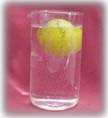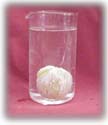


Missouri Grade Level Expectations for 2nd Grade:
Strand 1: Properties and Principles of Matter and Energy
1.1.A. Objects, and the material they are made of, have properties that can be used to describe and classify them.
Knowledge Objective: Students will know that some objects float and other objects do not float, but sink based on the density of the object.
Performance Objective: Students will predict which sphere will float or sink, carry out an experiment, and record data of their findings.


Concept Introduction:
Students will understand that objects can float, sink, or both because of the density of the object. Things that float are less dense than water. Things that sink are denser than water. They were able to record their findings by observing the action that took place with the sphere in water. Students were able to draw out a picture of what float and sink looked like.
Materials
needed for Activity:

1. small, medium, large spheres
2. clear containers
3. water
4. data chart
Vocabulary:
Sphere- a set of points in three-dimensional space equal in distance around the center of the sphere.
density- is the measure of mass per volume. The higher the objects density, the higher the mass per volume. A denser object (sphere) will have less volume than an equal mass of some less dense substance (such as water)
Sink- fall or drop to a lower level
Float- something that remains on the surface of a liquid
History:
The density of an object will determine if the object will sink or float in water. An object will sink if its density is greater than the water, and will float if its density is less than the water it is in. Water tries to support solid objects. If the objects are heavy for their size, the objects will sink. If the objects are light for their size, the objects will float. an object that is heavy for its size is said to have high density. Density is how heavy something is compared to its volume. If the amount of water that is displaced weighs more than the object, it will float. If the displaced water weighs less than the object, it will sink. Finally, sinkers can be made to float and floaters can be made to sink.
Float Sink
Activity
(Exploration):


The students will be put in groups, each having three sizes of spheres, clear water half filled in a glass container, and a data chart. Based on the weight of the sphere will determine whether the sphere will sink or float due to density, whether the density of the object is less than or greater than the liquid. The student will observe and record their findings after they placed the spheres in water and seeing the reaction.
Data (Exploration):
The Students will be asked, "Which of these spheres would float?" There would be three sizes of spheres, small weighing 1 pound, medium weighing 10 pounds, and large weighing 50 pounds. "Based on their weight, which of these spheres would sink or float." The students will be put in groups, each having three sizes of spheres, clear water half filled in a glass container, and a data chart. The students will first make a prediction of which sphere will float or sink by recording their predictions on a prediction chart. Then, the students will test which sphere will sink or float by dropping a sphere into a clear container and watch what will happen to the sphere. The students will record their results on their data chart circling the word marked 'sink' or 'float'. Then, the students will draw a picture of what happened to the sphere when it was dispensed in water. The students will write down their conclusions of why the sphere sank or float.

Activity Enrichment (Application):
Students will grab different objects with different weight. They will weigh the object at home, name the object and record it on a data chart. They will test the objects they found (at least 4 objects), in water. Students will add salt to the water to see if there are any changes to the objects after testing the objects in plain water.
Click on the arrow to view the student page or click on the links below.
Student Page:
Exploration: sphere data chart
Application: change in water data chart
Resources Link: